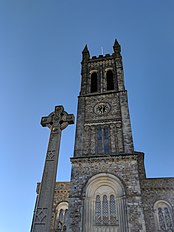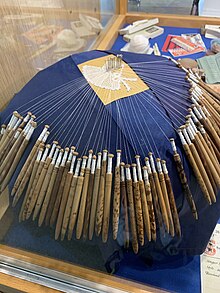Honiton
The town grew along the line of the Fosse Way, the ancient Roman road linking Exeter (Isca Dumnoniorum) to Lincoln (Lindum).
Contrary to 19th-century theories, it is unlikely to have been known as a stopping-point by the Romans, who built a small fort for that purpose just to the west of the present town.
Honiton's location is mentioned in the Domesday Book as Honetone, meaning Huna's tun or farmstead.
[3] Honiton later grew to become an important market town, known for lace making that was introduced by Flemish immigrants in the Elizabethan era.
Honiton Garage dates from about 1700 and the Market Hall (which originally had arcades on the ground floor and an assembly room above) has a modest early-19th-century stone front.
[8] St Michael's Parish Church, which was rebuilt in 1911 after a fire, is situated on a small hill above the town.
There are pinnacles on the tower and the arcades inside have tall columns; above the nave is a clerestory which resembles those in early Christian basilicas.
It is located in a building, claimed to be the oldest still extant in Honiton, which formerly belonged to Allhallows School from the 16th Century until the 1930s.
[11] Honiton was granted a royal charter in 1221 during the reign of King Henry III that allowed it to hold a market.
[13] At the beginning landed gentry took pleasure in throwing hot chestnuts from windows to local peasants and over time these gave way to hot pennies, a seemingly philanthropic gesture resulting in burns (until the peasants figured out to wear gloves or use a cloth to pick the pennies up).


